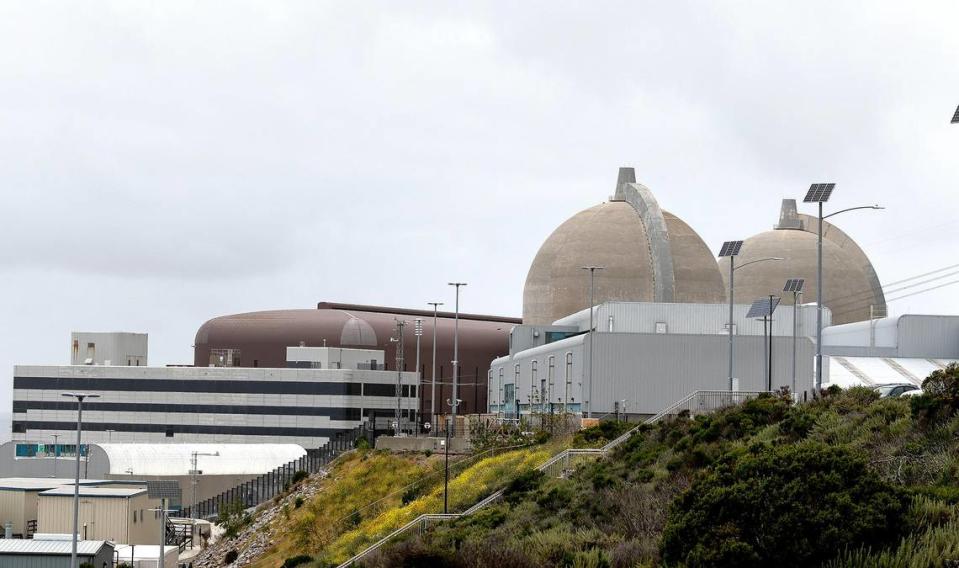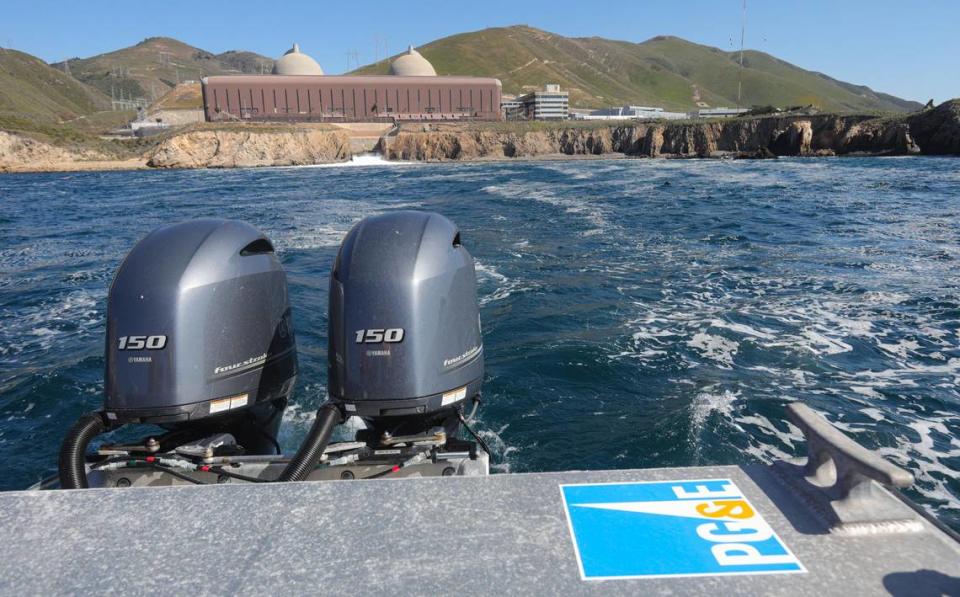PG&E files application to keep Diablo Canyon nuclear power plant running another 20 years
PG&E has filed its relicensing application to keep California’s last nuclear power plant running 20 years beyond its scheduled closure date.
The application was submitted to the U.S. Nuclear Regulatory Commission on Tuesday morning and comes a year and two months after Gov. Gavin Newsom signed Senate Bill 846 to allow extended operations at the 2,200-megawatt Diablo Canyon nuclear power plant in coastal San Luis Obispo County.
PG&E had planned to shut down the plant’s two reactors in 2024 and 2025.
The bill came after the state failed to procure enough clean electricity to replace the nuclear power plant before it was slated to shut down in the coming years. Diablo Canyon, which provides about 9% of the state’s electricity supply, has since become California’s best solution to ensuring the state has a reliable energy grid as electricity demand rises in the face of climate change, electrification and other factors.
“PG&E is committed to answering the state’s call to ensure the continued operation of the facility and safely deliver affordable, reliable and clean energy for California,” PG&E CEO Patti Poppe said in a prepared statement Tuesday. “It would be a great honor to continue serving California for as long as the state supports the operation of the facility.”
SB 846 allowed PG&E to forego compliance with state water laws regarding Diablo Canyon Power Plant’s cooling system operations through Oct. 31, 2030 — pushing new potential shutdown dates of the nuclear power plant’s two reactors to 2029 and 2030.
Additionally, SB 846 allocated $1.4 billion for a forgivable loan from the state to PG&E to help fund the continued operations of the power plant. The U.S. Department of Energy then granted PG&E $1.1 billion in November 2022 to help keep the power plant running, which PG&E has said it’ll use to pay back the state’s loan and lower costs to ratepayers.
Those funds, however, were conditional on the utility gaining approval from the NRC to continue operating the power plant located just north of Avila Beach.

License renewal application review could take multiple years
The license renewal application submitted Tuesday will kick off a long review process by the NRC.
First, the NRC will determine whether the application PG&E submitted was sufficient for a full review. That determination could take about 30 to 60 days, said Tom Jones, PG&E’s senior director of regulatory, environmental and repurposing, in a call with Tribune reporting and editorial staff Monday.
Should the NRC determine PG&E’s application was sufficient, the agency will then start its full review. An application review can take up to five years, but typically is between 22 months to 30 months, according to the NRC.
According to the NRC’s website, prior to submitting their applications, applicants “should have analyzed the management of aging effects in sufficient detail to conclude that the plant can be operated safely during the period of extended operation.”
If the license renewal application is deemed sufficient, the NRC has already allowed PG&E to continue operating the Diablo Canyon nuclear power plant beyond 2024 and 2025 even though it likely won’t finish the full review of the license renewal application before then. That decision was made in March and was appealed in June by anti-nuclear groups in federal appeals court.

The public will have opportunities to participate as the NRC reviews PG&E’s application, including at meetings and in reviewing the documents.
Additional legislation needed to keep plant running past 2030
PG&E’s application seeks to extend Diablo Canyon’s operations by another 20 years — or until 2045.
“By applying for the 20-year license, we afford the state a window of opportunity for 20 years,” Jones said.
Should 2030 come and the state still need energy from Diablo Canyon, having the 20-year license would ensure PG&E wouldn’t have to go through the license renewal process again at that time, Jones added.
However, additional state legislation would be required for the power plant to continue operating that long, according to Jones. That’s because, as outlined in SB 846, the power plant would need to comply with state water laws by 2030.
How California’s last remaining nuclear power plant transformed marine life off the coast
The California State Water Resources Control Board has said Diablo Canyon’s once-through cooling system violates state laws because it degrades native, cold-water marine life and has allowed non-native, warm-water marine life to grow.
Diablo Canyon pumps nearly 2.5 billion gallons of ocean water through its cooling system every day — killing larvae and small organisms sucked into the intake structure and significantly warming the 40-acre Diablo Cove at the discharge structure at the base of the power plant.
An alternative to the once-through cooling system has long been deemed unaffordable and unfeasible by the utility.
Application comes 13 years after PG&E previously sought to renew Diablo Canyon license
PG&E’s path toward applying for license renewal has been long and complicated.
The utility first applied to renew the power plant’s license for the two reactors in 2009. However, in 2016, PG&E announced the power plant would shut down the reactors at the end of its current license operating period — 2024 and 2025.
The 2016 announcement came after PG&E entered into a contract with environmental and labor groups to close Diablo Canyon and work with the California Public Utilities Commission to replace it with sources of clean and renewable energy.
At the time, the contract was largely celebrated as the state’s final move away from nuclear power. The Los Angeles Times reported after the decision that PG&E had taken “a bold step in the 21st century electricity revolution.”

The California Energy Commission has blamed development delays and supply chain constraints in the solar, wind and energy storage markets for the failure to replace the 2,200-megawatt power plant before 2025.
Since 2016, PG&E has been on a path to decommission the plant and find new purposes for the 12,000 acres of land surrounding it.
Even though the power plant may run past 2025, some decommissioning activities — such as constructing storage facilities and security-related buildings needed for decommissioning — could go on while the plant is in operation, according to an environmental review of decommissioning by San Luis Obispo County.
Lawsuits, petitions fight continued operations at Diablo Canyon
Anti-nuclear groups have fought PG&E nearly every step of the way as it prepared to file the license renewal application.
In April, Friends of the Earth filed a lawsuit in San Francisco Superior Court alleging PG&E will violate the 2016 contract to close the plant if Diablo Canyon stays open. A judge dismissed that case in August.
Additionally, San Luis Obispo Mothers for Peace, Friends of the Earth and the Environmental Working Group filed a petition in June in the U.S Ninth Circuit Court of Appeals. The groups argue in the appeal that the NRC improperly granted PG&E the ability to operate Diablo Canyon past its scheduled closure date while the agency was expected to review the license renewal application.
That case remains underway in federal appeals court.
Those groups have also filed petitions this year with the NRC requesting the power plant be shut down due to various safety concerns including the risk of damaging earthquakes and the possibility of cracking equipment.
PG&E has long maintained that it operates the Diablo Canyon nuclear power plant safely and in accordance with NRC regulations.

